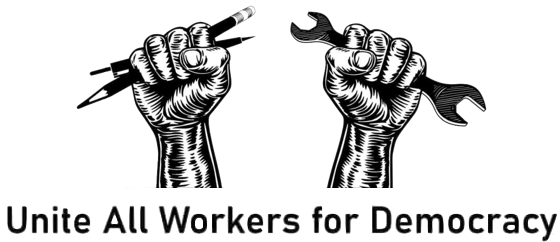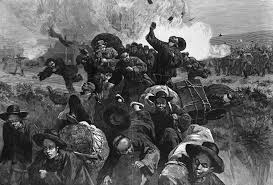Follow Erik Loomis on Twitter
Read Erik Loomis on Lawyers, Guns, & Money
Historian Erik Loomis on This Day in Labor History: September 2, 1885. White miners in Rock Springs, Wyoming killed at least 28 Chinese miners. Let’s talk about the power of white supremacy in the Gilded Age white working class and how white workers have chosen racial identity over class identity.
White Americans hated the Chinese.
There isn’t really much reason to complicate the above sentence when talking about the 19th century. Its truth is indisputable.
From the moment whites crossed the deserts in search of California gold and realized there were Chinese people there (and Mexicans and Indians and Chileans and a lot of other non-whites), they wanted to eliminate them.
In California, they very quickly stole the mine claims from the Chinese and forced them to do traditional female labor in this all-male society (this is the root of the Chinese laundry and ubiquitous small-town Chinese restaurant).
The Chinese — desperate to find economic opportunities not existent in their home country — still continued to come to the United States despite the racism and violence they faced.
This led to the first successful labor movement in the American history–the working-class led movement to end Chinese immigration. This is an important point–the Chinese Exclusion Act was the culmination of a working-class movement.
That 1882 act ended Chinese immigration for 10 years, but was no guarantee to the permanent dominance of white supremacy.
Of course, employers understood how they could take advantage of this racial animosity to divide their labor forces. The railroads jumped all over Chinese labor.
The Central Pacific Railroad used the Chinese as nearly slave labor to build the Transcontinental Railroad, starving them when they protested over their terrible conditions.
10% of the 12,000 Chinese laborers who worked on building that railroad over the Sierra Nevada died on the job. The conditions weren’t that much better for the Chinese in Wyoming in the 1870s and 80s.
The Union Pacific Railroad — who owned a tremendous amount of western land thanks to federal handouts to entice railroad construction — first brought in the Chinese to their western Wyoming coal mines in 1875 after white labor struck over low wages.
When Union Pacific broke the white union, only 50 whites were hired back to go with the 150 Chinese laborers.
The numbers of Chinese miners grew over the next few years, with whites angry first that the Chinese were taking away jobs that rightfully belonged to whites and second that they took jobs for less money and worse conditions than whites would tolerate.
Many of the white miners belonged to the Knights of Labor, which opposed Chinese immigration (as did most labor organizations during these years).
Throughout 1885, beatings of the Chinese increased in towns throughout Wyoming. In August, miners placed notices across the western Wyoming mining camps demanding the expulsion of the Chinese.
On September 1, white miners met at night and — while we don’t know exactly what happened in that meeting — it seems clear that the plans for the next day were set.
The next morning, ten members of the Knights walked up to Chinese laborers in a mine and told them they had no right to work. They then beat two Chinese miners — one to death.
Over the next few hours, a mob gathered in the center of town. Armed with rifles, around 150 whites marched into Chinatown.
At first, the miners gave the Chinese an hour to pack up and leave. But they got tired of waiting around. Thirty minutes later, they opened fire, killing a Chinese miner named Lor Sun Kit.
The Chinese panicked and began fleeing out of town in any possible direction while the whites beat, robbed, or killed everyone they could find.
Said the survivors in a report to the Chinese consulate in New York, “Whenever the mob met a Chinese they stopped him and — pointing a weapon at him — asked him if he had any revolver, and then approaching him they searched his person, robbing him of his watch or any gold or silver that he might have about him, before letting him go. Some of the rioters would let a Chinese go after depriving him of all his gold and silver, while another Chinese would be beaten with the butt ends of the weapons before being let go. Some of the rioters — when they could not stop a Chinese — would shoot him dead on the spot, and then search and rob him. Some would overtake a Chinese, throw him down, and search and rob him before they would let him go. Some of the rioters would not fire their weapons, but would only use the butt ends to beat the Chinese with. Some would not beat a Chinese, but rob him of whatever he had and let him go, yelling to him to go quickly. Some, who took no part either in beating or robbing the Chinese, stood by, shouting loudly and laughing and clapping their hands.”
The Rock Springs Massacre is one of the most horrible moments in American history, but it is little known today.
That night, nearly every building in Chinatown was burned. The majority of the dead were burned in their homes, either unable to leave because of illness or injury, or unwilling to leave and tried to hide in a cellar or some other seemingly safe place.
The survivors fled to Evanston, after being picked up by passing Union Pacific trains, but that town was no more welcoming to the Chinese than Rock Springs.
The governor of Wyoming appealed to President Grover Cleveland for federal troops to quell the rioting. Cleveland — always willing to send in federal troops to crush organized labor (even if in this case they deserved it) — obliged.
Six companies of troops arrived in Rock Springs a week later to escort the Chinese back to Rock Springs where they found ashes and the unburied bodies of their friends and family, half-eaten by dogs and vultures.
The Chinese just wanted out of Wyoming at this point, but Union Pacific had no interest in giving up their cheap, exploitable labor. They asked for railroad tickets to another state and then for two months of back pay the company owed them. Union Pacific refused all requests.
The Chinese at first refused to work, fearful for their lives, but then the company stopped feeding them, leaving them a choice of whether to work or leave Wyoming on their own.
White miners throughout Wyoming went on strike to protest the return of Chinese labor to the mines, but the strike was defeated and the Chinese remained. A few whites were arrested, but all were released in a month. No one ever faced charges for the murders.
The expulsion of Chinese laborers from workplaces and towns around the West continued through the 1890s.
In a point I repeatedly make in these threads and in my strikes book, if your analysis of American labor history doesn’t place race and white identity at the forefront, you are simply refusing to understand our past and present.
Class solidarity sounds good. It also doesn’t fit with how white workers have acted for the vast majority of American history, including the present by and large. The Rock Springs Massacre is but one of many examples of this. I will continue repeating this point to my death.

